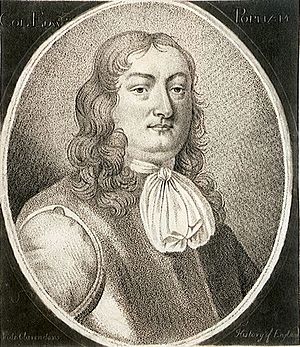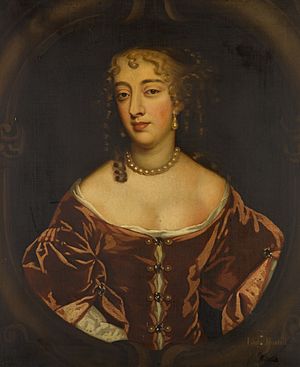Edward Popham facts for kids
Edward Popham (born around 1610, died 1651) was an important leader in the English navy during the English Civil War. He was known as a "general at sea," which was a top naval commander position at that time. Popham strongly supported the Parliament side during the war.
In 1644, he was chosen to be a Member of Parliament (M.P.) for Minehead. He led soldiers in the areas of Somerset and Dorset. Later, in 1648, he was put in charge of organizing the navy. He commanded ships in the Downs (a sea area near England) and the North Sea in 1649. In 1650, he joined another famous naval leader, Robert Blake, near Lisbon. Together, they blocked Prince Rupert's ships.
Contents
Edward Popham's Life
Edward Popham was the youngest of five sons of Sir Francis Popham. He was likely born around 1610. His older brother, Alexander, was born in 1605.
In 1636, Edward Popham was a lieutenant on a ship called HMS Henrietta Maria. This ship was part of a fleet led by Algernon, Earl of Northumberland. In March 1637, Edward became the captain of another ship, the Fifth Whelp. The "Whelps" were older ships and not very strong. On June 28, 1637, during a strong wind near the coast of Holland, the Fifth Whelp began to sink. Popham and his crew barely managed to escape in a small boat. Sadly, seventeen men went down with the ship. After rowing about 50 miles, they found an English ship that took them to Rotterdam.
In 1639, Popham commanded a ship, possibly the Rainbow. He was with Sir John Penington's fleet in the Downs.
Fighting in the Civil War
When the English Civil War began, Edward Popham joined the side of Parliament. His father and brother Alexander also supported Parliament. After his father passed away, Edward took his place as the Member of Parliament for Minehead.
In 1642, Edward and his brother Hugh helped Alexander gather soldiers for Parliament in Somerset. By May 1643, Colonel Popham led a strong group of horse and foot soldiers in Dorset. He helped protect Dorchester from Prince Maurice's forces. This was likely Edward, as Alexander was in Bristol at that time.
In June 1644, both Edward and Alexander Popham were sent to Somersetshire to find more soldiers. This was a risky job because they had to travel through areas controlled by the enemy. On June 11, 1645, Edward was asked to go to Romsey. There, he was to take command of troops gathering to help Taunton. He was to follow the orders of Colonel Sir Edward Massey. It seems Edward was considered the higher-ranking officer at this time. He probably took part in the western battles of July, including Ilminster, Langport, and Bridgewater.
On July 17, 1648, Edward Popham was told to go to sea with Robert, Earl of Warwick, who was the lord admiral. This was because Charles, Prince of Wales had a group of ships on the coast.
On February 24, 1649, an act of Parliament named Popham, Blake, and Deane as special leaders for the navy. Popham was given the highest rank among them. This was likely because of his experience and rank in the navy. Blake had also served under one of the Pophams before, possibly Edward.
During 1649, Popham was in charge of ships in the Downs and the North Sea. In these areas, private ships from different countries were attacking English merchant ships. These privateers had permission from the Prince of Wales to attack. On August 23, the town of Yarmouth sent three sheep to Popham's ship as a gift. They thanked him for protecting their ships.
In early 1650, Popham was ordered to join Blake near Lisbon with more ships. He set sail with eight ships in late April. After joining Blake, they were both on the ship Resolution. On July 26, Prince Rupert tried to escape from the Tagus River. But the Parliament's ships were watching closely. Rupert was forced to anchor under the castle's guns. Two days later, he gave up and went back to Lisbon.
Final Years and Legacy
In November 1650, Popham returned to England. Soon after, he went back to his post in the Downs, commanding ships in the North Sea. He died of a fever in Dover on August 19, 1651. He was still in command, even if not on his ship. The news reached London on August 22.
The government ordered Sir Henry Vane the younger to visit Popham's wife, Anne. He was to tell her that the government remembered her husband's great service. They promised to help his family whenever they could. His widow, Anne, was given a year's salary.
Edward Popham was buried with honors in Westminster Abbey. A monument of black and white marble was built to remember him. Later, the monument was moved to a different chapel in the Abbey. The words on it were removed, but the monument itself is still there.
Edward Popham's Family
His Wife and Children
In 1645, Edward Popham married Anne Carr. Anne was born around 1623. Her father, William Carr, had worked for King James I.
Edward and Anne had two children. Their daughter, Letitia, was born around 1648. Their son, Alexander, was born around 1649. Alexander was born deaf.
A Special Story: Learning to Speak
About ten years after Edward Popham died, his widow Anne married again. She had many children from her new marriage and Edward's children to care for. Anne wanted her son Alexander to be able to communicate. She asked Dr. John Wallis in Oxford to teach Alexander Popham to speak. Dr. Wallis was successful! This was one of the first times it was recorded that a deaf person learned to speak. Alexander later married and had a daughter named Anne, who was not born deaf.



